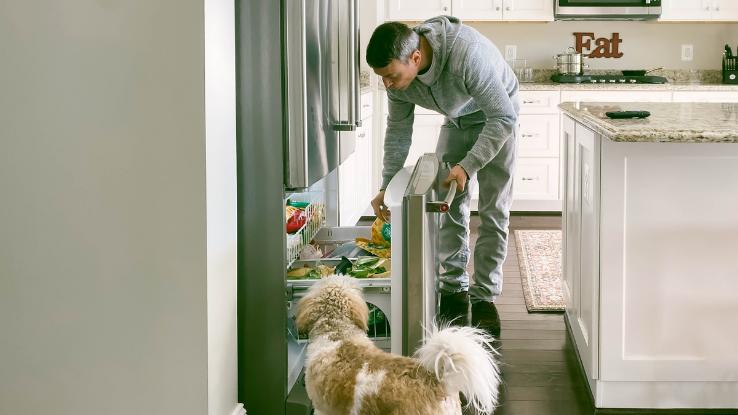
Why do foods change color and texture after being in the freezer for a long period of time? This change is called “freezer burn,” and occurs when a food that’s been left in the freezer loses its moisture.
Freezer burn is marked by visible ice crystal, which grow on the outside of certain foods, and at times, discoloration. For example, a piece of red meat with freezer burn may turn a grayish brown, while chicken with freezer burn tends to become darker. Whatever the case, this discoloration indicates that the frozen food has suffered from dehydration and oxidation.
So, is it safe to eat foods that’ve been impacted by freezer burn? And, better yet, is there a way to prevent freezer burn in the first place? We’re taking a closer look.
Why Freeze Foods?
We freeze foods to preserve them for extended periods of time. That is, properly freezing food can help to slow the growth of bacteria and other microorganisms, which can lead to sickness if eaten. According to the United States Food Safety and Inspection Service (FSIS), food that’s consistently stored at zero degrees Fahrenheit and thawed appropriately is considered safe to eat.
In fact, freezing raw meat and poultry is more effective for maintaining quality than storing cooked versions because the cooking process can cause the meat and poultry to lose moisture. Following this line of logic, cooked foods are more at risk for freezer burn and shouldn’t be stored in the freezer for as long as raw food products.
What Causes Freezer Burn?
When foods are kept in the freezer, the water molecules within them begin to form ice crystals. Food dehydration occurs when these water molecules naturally move to the coldest area of the freezer, which is typically the sides or the back of your freezer; just check the portion of your freezer that seems to be accumulating the most ice or ice crystals. The longer you keep food in the freezer, the more molecules will transfer from the foods to the colder area of the freezer. The end result? The frozen food will lose its water molecules, leading to freezer burn.
Oxygen can also increase the risk of freezer burn. If food is not properly packaged or sealed from the external freezer environment, exposure to oxygen molecules in the air can lead to chemical or pigment changes that impact the food’s color, texture, and flavor.

Is It Safe to Eat Food With Freezer Burn?
Although the appearance might make you think otherwise, foods that have suffered freezer burn are, in fact, safe to eat. Many people tend to throw out entire packages of frozen food upon the mere sight of discoloration believing that the meat has gone bad or spoiled; however, this is not the case.
Oftentimes, only a certain portion of the food suffers from freezer burn, depending on the packaging. It is safe to remove and discard these portions and consume the rest of the food once thawed. You can also still consume the entire serving, including the freezer-burned areas, but keep in mind that the texture and taste of the food will likely be affected since the food has lost much of its fluid content.
Ways to Prevent Freezer Burn
To avoid unnecessary food waste, here are some precautionary measures you can take to prevent freezer burn and keep your frozen foods fresher longer:
- Make sure that all food is tightly sealed and wrapped before being placed in the freezer.
- Use sealable plastic bags, air tight containers, vacuum packaging, or double-wrap your frozen food to prevent water molecules from escaping.
- Do not store foods in the freezer for extended periods of time. The longer a food stays in the freezer, the higher the risk of freezer burn.
- Spread out new items in the freezer and only stack them once completely frozen, to speed up the freezing process and avoid fluid dripping.
- Check your freezer’s temperature and make sure it is set to 0 degrees Fahrenheit. Fluctuating temperatures will increase the risk of freezer burn.
- Avoid over-filling the freezer as this can impact its temperature.
- Avoid placing hot food directly into the freezer. This will cause a change in the freezer’s temperature.
- Do not leave the freezer door open.
Though often unsightly, freezer burn on foods is not dangerous and is considered safe to eat. However, you might wish to discard frozen foods that are heavily affected by freezer burn because of changes in their flavor and texture related to loss of moisture. The taste, aroma and texture of a food suffering from freezer burn can be unpleasant.
However, frozen food can still be salvaged if only a small portion has been affected by freezer burn. In that case, you can simply cut and discard the freezer-burned areas and still enjoy the full flavor and quality of the rest of the food.
Resource Links:
- “Freezing and Food Safety” via Food Safety and Inspection Service, U.S. Department of Agriculture (USDA)
- “What Is ‘Freezer Burn’? ” via Everyday Mysteries, Library of Congress
- “The science of freezing foods” via University of Minnesota Extension
- “Advances in Meat Preservation and Safety” via International Journal of Science and Research (IJSR), ResearchGate





